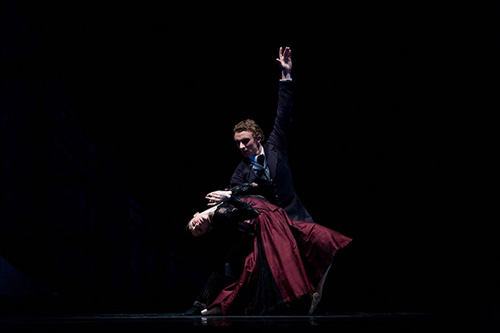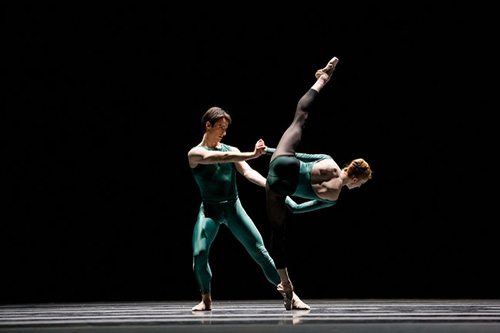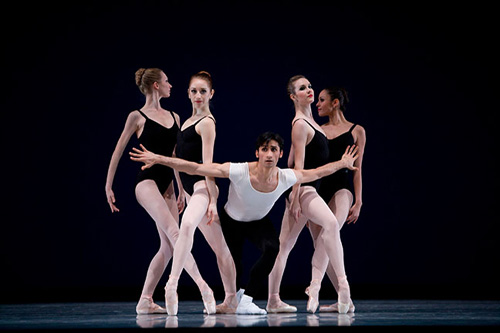|
It's impossible to look at the season openers of San Francisco Ballet (Program I and II) without remembering the rather malicious review Joan Acocella wrote last fall in the New Yorker when the company was on its 75th birthday tour. Her portrait of the company, "Pacific Heights," (Nov. 3, 2008) states that many of the women dancers are "knock-outs" but look like "ballet school recitalists" when they ought to rise to "heroic" stature: "In dark psychological works, like 'The Four Temperaments,' some of them smile. They don't seem to realize what's going on." Most importantly, according to Acocella, they lack "diva scale."
Acocella is the undeniable Popess of American ballet criticism, but must we assume she has never seen Muriel Maffre or Lorena Feijoo, to name just two of the most "heroically endowed," established stars of the large company? Maffre has only just retired and Feijoo is at the height of her art: she is not only unrivaled in lyrical, musical phrasing, she is a passionate, dramatic, technical marvel. Everyone knows that Cuban dancers everywhere are at the top of the "diva scale". Could it be that Acocella missed out on the star power of certain San Francisco's ballerinas because of unfortunate casting decisions the day she happened to cast a glance at them?
Yuan Yuan Tan and Anthony Spaulding
Casting, indeed, is plaguing the company where so many principal dancers vie for every part and each one of them gets only one night of the short program run (if any), whether the part fits them or not – unless certain guest choreographers put their foot down for "their" dancers and give them the whole run. Lorena Feijoo, to stay with my example, had four parts in the two first programs I saw, but if Acocella had been in the audience, these two nights might not have been much of an eye-opener. None of these parts gave Feijoo a chance for a star turn.
Feijoo was chosen by ex-principal dancer and by now resident choreographer Yuri Possokhov in his third creation for the company. "Diving Into the Lilacs", a charming romp for three couples and a group of nine dancers, mixed humorous and tender Russian folkloristic elements into what at times seemed archaic village dances – a light-hearted version of "Spring Awakening," not set in Wedekind's Germany but somewhere in a nostalgic Russia. A slide-projected strip of lilac bushes cut across the backdrop of the dark stage and dreamily changed its color and mood to a "Sinfonietta for String Orchestra" by a certain Boris Tchaikovsky (a minor successor of his namesake.) The first pas de deux showed off the tiny Russian ballerina Maria Kochetkova. With her crystalline pureness of line, lightness and speed she was a swirling last snowflake or the first spring butterfly, all childhood innocence. Here is a young dancer with enough sure-fire technique, charm and ambition to out-dance a number of New York divas in the years to come.
The lilacs came into higher bloom with Yuan Yuan Tan. Acocella happens not to like Yuan Yuan Tan, for reasons of her own. She finds her "presentational, a sort of ballet-competition type" – whatever that might mean. "Tan, a favorite in San Francisco, is less loved on the road," she claims. Really? Should we ask for statistics? Tan can be ephemeral to the point where she seems to withdraw into her own almost transparent shadow, appearing cool and remote. But she is the archetypal embodiment of weightless classical grace and beauty and if you have been lucky enough to see her in dramatic roles like Desdemona or Juliet (see my review from June 2005 in the Archives) you know how far her emotional range can go. Possokhov created an ideal part for her. Romantic ambivalence, longing and resistance, fear of being overwhelmed by her convincingly arduous lover, Anthony Spaulding, were superbly and touchingly portrayed. With the third couple, Lorena Feijoo and Joan Boada, the choreographer, alas, seemed to have run out of ideas. Suddenly his evocation of spring stalled. He didn't find a character or motivation for his final couple. Instead of "Lilac Wine" intoxication or any anticipation of summer heat he basically repeated his general gamboling spring theme. A wasted occasion. His two soloists served this anticlimactic ending with joyful conviction and – no surprise here — technical perfection.
 |
Lorena Feijoo and Quinn Wharton
Similarly promising and yet not quite satisfying was "Ibsen's House" by Val Caniparoli (in Program II), an attempt to present five of the Norwegian playwright's dramatic heroines to a piano quintet by Antonin Dvorak. The American choreographer who once also was a San Francisco principal, brought some interesting ideas to the formal structure of the piece. Set in a dark, abstract room with a prominent window curtain, symbol of the confinement of Victorian women in their "marriage cage," Caniparoli started by presenting each woman on her own. These solos expressed plights and sufferings that seemed vague, mysterious, and somewhat interchangeable, even though Caniparoli reverted to pantomimic gestures to indicate character: Hedda Gabler (Lorena Feijoo) kept her mouth shut with one hand, as if to indicate she harbored dark secrets; Nora from "A Doll's House (Clara Blanco) kept anxiously straightening her skirt, etc.) More contradictory feelings came to light when the women engaged in duets with their lovers, husbands, patriarchal tormentors. In spite of continuously engaging movements and dancing, however, the sum of the whole remained predictably slight. Lorena Feijoo stood out with her innate authority and always remarkable musicality, but once again, choreographically speaking, she didn't get enough meat on her bone.
It didn't help to know that Hedda Gabler is one of the most complex heroines of Ibsen's dramas. She despises her weak husband and in criminal ways tries to force his career, but, like an "eagle in a cage" she tragically self-destructs. The play is being reprised this season in New York and critic John Lahr reminds us in the New Yorker (Feb. 9 & 16) that Ibsen, "was an archeologist of the modern psyche, one of those visionaries, as Freud observed, whose findings 'troubled the sleep of the world.''' Psychic depths of this order could not be rendered by choreographic vignettes that lasted a few moments, when each of the women would have deserved a whole story ballet. Caniparoli redeemed himself, however, when the males appeared as a group without their women and revealed even graver torments and inner incertitudes with flailing limbs and body contortions. For once it wasn't the women who carried the hysteria: a welcome modern insight that made up for some of the generalities of Ibsen's House.
Something unexpected happened in Prism (Program I), a tried-and-true Helgi Tomasson excercice de style (created in 2000) that could be called would-be-Balanchine. The first movement (of Beethoven's piano concerto No 1) seemed outright grandfatherly, featuring a bland Vanessa Zahorian. Acocella would probably repeat that Tomasson is "a boring choreographer, classical in the pretty, empty, everything-is-beautiful-at-the-ballet manner." But even though I missed out on Taras Domitro's high-flying presence in the casting of that night (see cover photo), Prism suddenly offered one long breath of inspiration with the second movement, the adagio. It featured Sarah van Patten in bewitching form, her musical qualities so beguiling that one hardly noticed there was also a partner behind her (the reliable and unimposing Brett J. Bauer). Echoed (or "prismed") by small groups of threesomes in the soft-hued, half-shadowed background, Van Patten transformed a lovely, predictable pas de deux into an emotional suspense story, using an unusual lyricism of head, neck and arm inclinations to curl and uncurl from movement to movement. The yielding fluidity and languid phrasing made this unfurling dance a revelation. Suddenly we were high up on the diva scale – and even Acocella couldn't deny the fact, although she did it begrudgingly: " The sensation of the season was the new principal dancer Sarah Van Patten. When she did grands jetés, people got out of the way."
 |
Katita Waldo and Ruben Martin
SF Ballet dancers usually put their best foot forward in serious challenges like William Forsythe's in the middle, slightly elevated , and this time they also managed in Balanchine's Four Temperaments. Both are masterpieces, equally hard to dance, and both were a thrill. Thanks to Tomasson's genius for programming, seeing them almost neck to neck, first The Four Temperaments (1946) in Program I and in the middle, slightly elevated (1987) the next night in Program II, the intimate link between the two works was in the spotlight. William Forsythe, post-Balanchine Wunderkind of Germany's Frankfurt Ballet, literally transposed and transcended the lessons of the old master into a modern, violent "exaggeration" to Thom Willems' throbbing techno beat. The movements are as explosive as the music, with extreme off-balance combat pas de deuxs, a constant pulse of group and solo movements in counterpoint, unexpected stops and starts, shocking tension and sudden release of bodies in space. Just as with Forsythe's other major oeuvre, Artifact Suite, almost a twin piece, San Francisco Ballet once again proved its passion and giftedness for the choreographer (see reviews from April 2007 and May 2008). Perhaps however, in the casting of that night, one element was missing: the heightened excitement of more extreme physiques or body types in the women. When you have seen Sylvie Guillem premiering the piece in Paris (or rehearsing it in a TV documentary) or watched Muriel Maffre's never-ending legs in one of Forsythe's combat duets, something – let's call it something slightly more elevated — was left to be wished for.
 |
Davit Karapetyan and soloists
The same holds true for the solo parts in The Four Temperaments (set to music by Paul Hindemith). Most convincing to me was the women's group with their high legs, their frighteningly advancing grand battement kicks, their saucy tendus and sexy hip thrusts. They were instructed by Elyse Borne, repetiteur from the George Balanchine Trust, and they all looked fabulous in their classic Balanchine outfits, black belted leotards, white tights, hair in little buns to underline the small heads and long legs the master wanted to see on his women. The Russian choreographer obviously knew what looked best in a modern version of the classical ballerina, and it was a joyful remembrance to witness that some of the ironic erotic playfulness of Balanchine's creation can still be recapped today. This said, I found the soloists miscast and, this time, had to agree with Acocella. The young new dancer Taras Dimitro showed a sensational back-bend but otherwise could not show off any of his Cuban pyrotechnics as the "Melancholic." And instead of casting the beautiful Parisian newcomer Sofiane Sylve, who appeared too laid-back and soft-edged as the "Choleric", Tomasson would have done better to give her Lorena Feijoo's "Sanguinic" part which would have fit her, while Feijoo would have tossed off the "Choleric" with the electric energy and fiery Cuban virtuosity that Acocella would qualify as "heroic" and, precisely, as "diva scale."
Cover Photo features Taras Dimitro
Photos © Erik Tomassont
Also In This Issue: Renate Stendhal's review of SF Ballet's Swan Rock
|
|

